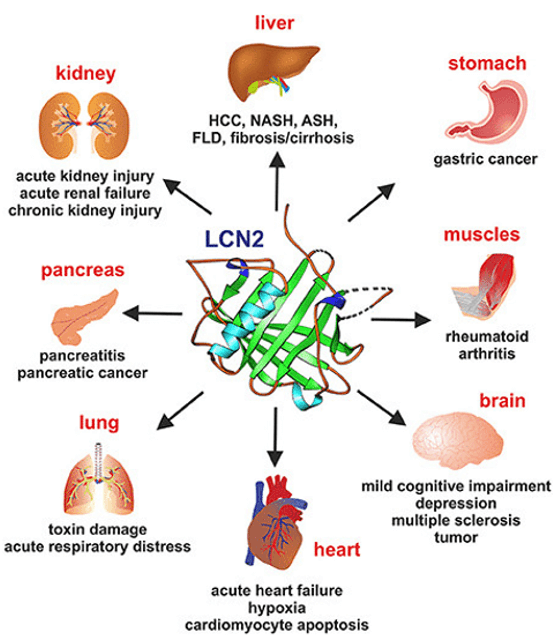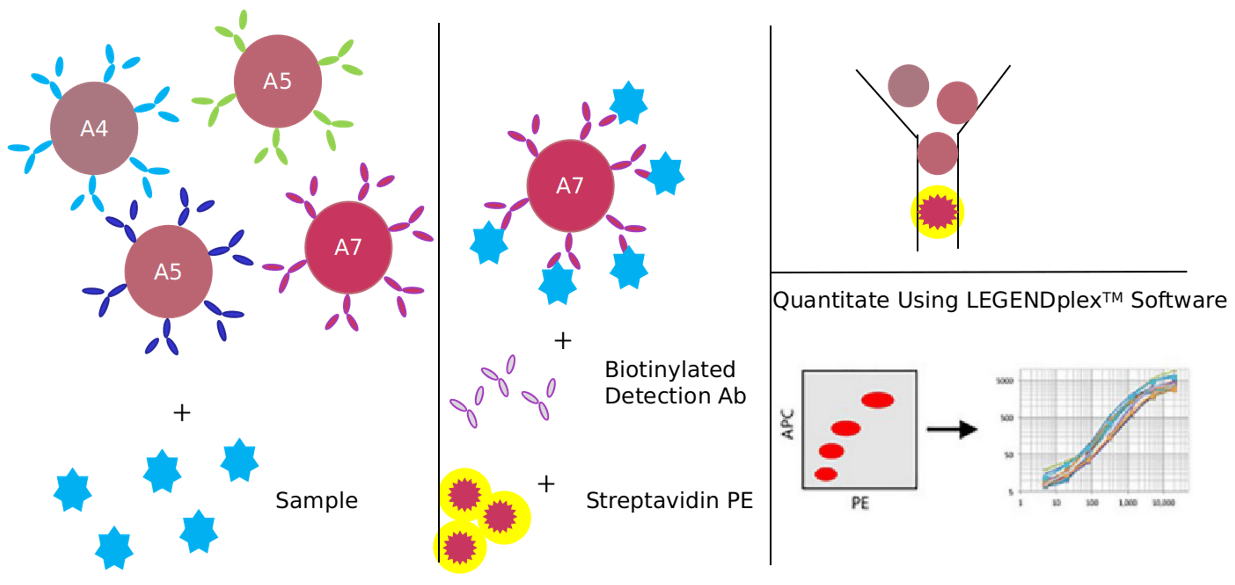LCN2 signaling pathway
Based on Luminex technology platform, Creative Proteomics provides analysis services for key targets of LCN2 signaling pathway.
 (Ghosh, S., et al. 2020)Lipocalin-2 (LCN2), a member of the lipocalin superfamily, also known as 24p3, p25, MSFI neutrophil gelatinase-associated lipid transport protein NGAL, which can be expressed in a variety of cells. It can act as a transporter protein for lipophilic small molecules such as steroids, lipopolysaccharides, iron and fatty acids. It has the typical tertiary structure of the lipid transport protein family, i.e. a β-barrel structure formed by eight reversed parallel β-turns.
(Ghosh, S., et al. 2020)Lipocalin-2 (LCN2), a member of the lipocalin superfamily, also known as 24p3, p25, MSFI neutrophil gelatinase-associated lipid transport protein NGAL, which can be expressed in a variety of cells. It can act as a transporter protein for lipophilic small molecules such as steroids, lipopolysaccharides, iron and fatty acids. It has the typical tertiary structure of the lipid transport protein family, i.e. a β-barrel structure formed by eight reversed parallel β-turns.
LCN2 is expressed in a variety of cells and is involved in the progression of multiple diseases and disorders. lCN2 plays an important role in the development, progression and metastasis of various cancers. In addition, aberrant expression of LCN2 has been associated with chemo- and radiation-resistant phenotypes of tumors. Its multiple functions and its widespread expression in different types of cancers suggest that LCN2 can serve both as a valuable diagnostic and prognostic biomarker and as a potential new therapeutic target. Besides, it is also involved in other cancers such as oral cancer, thyroid cancer, esophageal cancer, colon cancer, bile duct cancer, bladder cancer, prostate cancer, ovarian cancer, breast cancer, uterine cancer, and leukemia.
In the tumor microenvironment, the LCN signaling pathway is associated with tumor-associated macrophages. It is involved in the proliferation and apoptosis of tumor cells, the invasion and metastasis of tumor cells, and the process of tumor angiogenesis, which affects the treatment and prognosis of tumors by combining different ligands and receptors to participate in iron transport, protecting matrix metalloproteinase-9 activity, and secreting cytokines.
Our detectable targets:
| IPS-1 | ATG5 | Rac1 | IRF9 | AMBRA1 | mTOR |
| ISGF3 | ATG12 | ULK | GAS | SH2 | ISRE |
| MSK2 | ATG2 | MYD88 | FIP200 | p38MAPK | IRAK1 |
| PI3K | ATG13 | JNK | PKR | Histone-H3 | TRAF6 |
| TBK1 | TRAF3 | ATG4 | TLR3 | TRAF5 | |
| Vav | RIG-1 | ATG3 | WIPi2 | RIP1 | |
| VPS15 | NFκB | ATG10 | ATG16 | IRF5 MEK3 | |
| VPS34 | UYRAG | ATG7 | TLR4 | p38 |
Technology platform:
We provide Luminex technology for LCN2 signaling pathway analysis.
Luminex technology is a multifunctional liquid phase analysis platform, which is developed on the basis of high-speed digital signal processing technology, colored microspheres, applied fluidics and laser technology. The core is the use of fluorescent dyes for encoding. By adjusting the different ratios of different fluorescent dyes, more than 100 microspheres with different fluorescence spectra were obtained. The reactions are carried out on microspheres with different fluorescent codes, such as nucleic acid hybridization, antigen-antibody, enzyme-substrate, ligand-receptor binding reactions. Using laser detection technology, qualitative and quantitative analysis of microsphere encoding and reporting fluorescence.
In addition to providing customers with luminex multiplex assay, we can also flow cytometry (FACS analysis), provide enzyme-linked immunosorbent assay (ELISA) technology to meet other customer needs.
Advantages of LCN2 metabolism signaling pathway detection:
- Good repeatability: The Luminex detection platform directly reads the fluorescence value, which is more stable and sensitive: 100 microspheres of each type are detected, and the median value is taken as the result, which is equivalent to 100 repeated detections for each sample.
- Low cost: Simultaneous detection of multiple indicators of a sample can save time, samples, reduce detection costs, and improve analysis efficiency.

Application of our service:
- Study the regulatory mechanism of LCN2 signaling pathway in clinical medicine
- Research on the influence of various medical viruses on LCN2 signaling pathway
- Study the effects of carcinogenic drugs or carcinogenic therapies on LCN2 signaling pathway
Creative Proteomics has developed a signal pathway target detection platform. We are not limited to providing LCN2 signal path detection services, but can also provide other signal path detection services. If you want to detect other targets, please contact us and we will customize the service for you. Look forward to working with you.
References:
- Asimakopoulou, A., S. Weiskirchen, et al. Lipocalin 2 (LCN2) Expression in Hepatic Malfunction and Therapy. Front Physiol, 2019, 7: 430.
- Ghosh, S., N. Stepicheva, et al. The role of lipocalin-2 in age-related macular degeneration (AMD). Cell Mol Life Sci, 2020, 77(5): 835-851.



